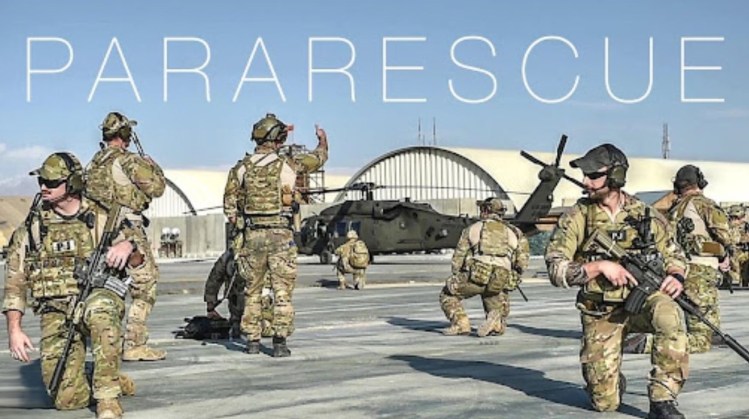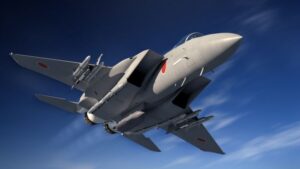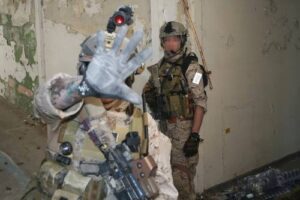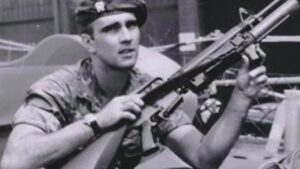Pararescuemen are known as PJs, for Pararescue Jumpers or simply ParaJumper. They hold a very unique position as USSOCOM (indeed all of DOD’s) only specific CSAR (Combat Search and Rescue) career field, trained and equipped to conduct both conventional and unconventional recovery missions, CASEVAC and MEDEVAC. They are not simply medics, and they are anything but unarmed. Their motto is That Others May Live, and their trauma medicine capabilities combined with SOF battlefield skills make them special even within the special operations community. Their missions take them on a wide array of missions, from combat rescues of downed pilots to patrolling into remote areas with Green Berets and CAG to supporting NASA missions. A little-known fact about PJs is their officers—they were for years an all-enlisted force until recently with the establishment of the Combat Rescue Officer. Over half of all Air Force Cross recipients are Pararescuemen. They wear maroon berets.
PJs trace their origins waaay back. Air ambulances were predicted back when CAS missions were pilots or gunners dropping hand grenades over the side of a biplane to the ground below. In WWII, Lieutenant Colonel Don Fleckinger and two medical corpsmen volunteered to drop into the jungle to provide treatment for a crew that had bailed out of a crippled C-46.
See also IMINT: Pararescue and Up in the Morning.
There a number of good websites and other resources for those interested in the PJ career field’s proud history and current lifesaving operations. Among them are:
ParaRescue.com (In particular their Pararescue (PJ) media page, which has a lot of material on it.)
Air Force Special Operations Command Heritage
Air Force Special Operations Training Center
Staff Sgt. Andrew Rios, 46th Expeditionary Rescue Squadron, talking about a training exercise in Afghanistan:
The Green Feet:
The “Green Feet and Lighting” are an unofficial emblem of the PJs. The following explanation of how they developed is copied from the Special Tactics website forums, as related by one of their moderators:
Here is the story from the CMSgt (Ret.) Wayne Fisk:
It all began one rainy monsoon morning when then Technical Sergeant Wayne Fisk, had just completed a 48-hour combat alert tour at Nakorn Phanom (NKP) Royal Thai Air Force Base, Thailand. In those days, the 40th Aerospace Rescue and Recovery Squadron, the famed Super Jolly Green Giants, was fragged to provide–in addition to its standard wartime commitment of combat rescue–continuous around-the-clock ground-alert in the event a DoD resource was downed in enemy territory and needed rescue/recovery. Specific emphasis was placed upon missions in Laos and Cambodia.
Such alert tours were not without excitement and rewards in the form of good combat missions; too bad this could not be said about the one Wayne had just finished. The only excitement he had faced during the previous two days was the prospect and anticipation of going downtown and “extinguishing” his “papa” low-level light once Nakorn Phanom village awoke.
Not so with Staff Sergeant Chuck Morrow who, at 1000 hours, was just returning from the vill’ after having successfully extinguished his low-level light. His stagger and played-out facial expressions told anyone foolish enough to ask that he and she–but most assuredly he–had been good, damn good. Chuck found Wayne in the barracks Jolly Green hootch bar, downing a few prior to heading for the vill’, not that one needed to be bombed in order to enjoy the finer aspects of NKP vill’, but it helped.
Wayne was considered “short” at this time as he was nearing the end of his fourth SEA combat tour, and he was contemplating some sort of personal souvenir for posterity to commemorate the milestone. A permanent dose of the clap had already been ruled out.
Chuck joined Wayne at the bar and liked what he was hearing. Through the haze of his already-inebriated mind and five continuous combat tours to his score, coupled with Fisk’s likewise rapidly increasing intoxicated state, the two mandated such a souvenir must be long-lasting, elitist, and depictive of valor–if not for the act of acquiring it, then at least for its symbolism. After much deliberation, accentuated by a number of previously told and re-told war stories, they decided: What could be more fitting than the highly revered and prestigious symbol of combat rescue in SEA, the Jolly Green Giant footprint! Yes, but a tattooed footprint!
The concept was born, but where were they to be affixed? Somewhere unusual, somewhere to gain attention–to command awe–when displayed. All standard–and perhaps not-too-standard–locations were quickly ruled out, except the cheeks of the butt. There: Plant them there! A rough sketch was drawn, more booze flowed, and it was off to the main gate that the two sloshed, slipped and slid, a righteous duo bent upon a holy mission.
But wait: Being the medical experts they were, they temporarily diverted to the PJ Section to procure a tube of Bacitracin-Neomycin ointment, a number of 4x4s, and some Lidocaine. One cannot be too careful when it comes to the refinements of hygienic techniques, especially in a land ridden with hepatitis. And, too, why suffer too much pain on a holy mission when Lidocaine was readily available, the thought being that the tattoo gun’s needles would simply drive the anesthetizing substance deep into the tissue, thus deadening any pain that was sure to be present.
By the time they reach NKP vill’ and Jimmy Wong’s tattoo “parlor” in a dingy bungalow near the Mekong River, they were well on their way to total inebriation. In other words, it was another typical off-duty Pararescue day.
Inside Jimmy was just completing the finishing touches on another customer. Wayne and Chuck sat down and waited their turn, which was a mistake. As they watched, Jimmy, perspiring mightily in the heavy, humid monsoon air, wiped away with a filthy rag the blood, sweat, and tattoo ink from the chest of the customer he was working on. Then he nonchalantly wiped away the sweat on his own brow. This process was repeated time and again throughout the period of waiting, accentuated by occasional fallings of the rag onto the dirt-strewn floor. Raised eyebrows of concern passed between Wayne and Chuck. Obviously they were not drunk enough to appreciate that which was transpiring before them. It was out the door to the curbside booze vender for a tall bottle of Mekong Whiskey to remedy the shortcoming.
Once back inside, pararescue etiquette was expressed as to whom was to go first. Wayne, acquiescing to cumulative combat tenure, offered Chuck the honor. Chuck, not so drunk that he could not relive visions of Jimmy’s hygienic procedures, insisted that since it was the former’s idea to begin with, Wayne should assume the prone position. He did, and the birth of the first Jolly Green footprint tattoo began to take shape.
But it was not without unplanned interruption. Despite copious amounts of Lidocaine having been applied to the tattoo site, when Jimmy, who obviously used his needles in a side business chipping paint from samlors, touched them to Wayne’s sensitive behind, a roar of surprise, pain, and anger bellowed from the room and assailed the peaceful vill’ beyond. Chuck, too, roared but with sadistic delight and ridicule of a many-tours-warrior grown impervious to the sights and sounds of pain and suffering. Scratch the theory that tattoo needles are as effective as sub-Q injections for the purpose of localized sedation.
Instead, Wayne was seriously seeking a full systemic sedation affect by way of straight-up chugs from the bottle of Mekong. Even the laughing Jimmy Wong joined in, downing sizeable amounts of the stuff, which most assuredly were to have an affect upon the outcome to the artistic endeavor.
Eventually both sets of tattoos were finished. The Great Quest had been fulfilled: Two bright sets of green footprints, framed by corona of tortured pink skin on pale butts. Both men were certain they sported the greatest symbols of warriorhood and manliness ever beheld.
And they shared the sources of their pride with everyone they met, usually at the slightest provocation or display of interest. Into every bar and dive they went, thrilling perhaps themselves more than others, but undeniably having a great time. Back at the squadron they became the envy of the rest of the PJ team, of the flight engineers, and of the pilots, who likewise rushed out to procure theirs. The aberrant had become the craze.
As the weeks sped by and Jolly Green footprint tattoos proliferated, other flight units on NKP began feeling out done and suffered an acute lack of attention. This was especially evident at the NCO and Officer Clubs where normally club managers became quite upset at the sight of a line of bare-assed GIs flashing the moon. It wasn’t long before other squadrons acquired their own squadron logo tattoos, and it soon came to be that hardly no one on NKP RTAFB was afraid to flaunt his *** in public. Jimmy Wong’s business began to flourish, and he soon purchased additional instruments to refinish even more samlors.
Thusly did the custom begin. From a humble, inebriated back-room beginning, the Pararescue procurement and flaunting of Jolly Green Giant footprints has spread throughout the world, shocking and delighting millions who have become the objects of–and sometimes unwilling sufferers bearing the brunt of–moon flashes. In some circles–admittedly more often than not in Pararescue circles–it is considered a serious breech of etiquette not to display these historic symbols of pride, valor, and commitment.
Today new generations of PJs have proudly carried them into battle. From the jungles of SEA to Panama, the Middle East, Somalia, the Balkans, and now to the worldwide crusade of ferreting international terrorists from their holes, they have left their impressions upon all who have witnessed.



